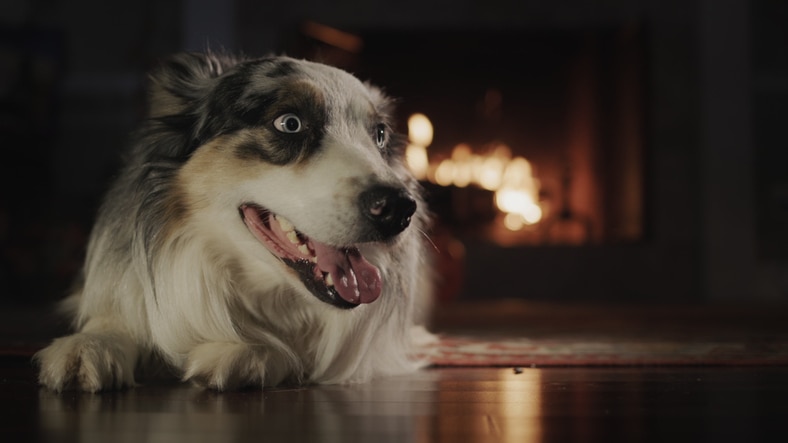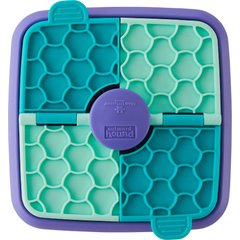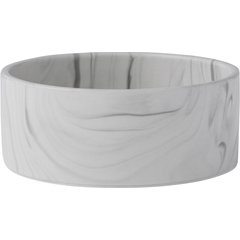Can Dogs See in the Dark? A Guide to Your Dog’s Night Vision

Photo by StockSeller_ukr/iStock/Getty Images Plus
While humans tend to stumble without a light on, dogs often seem to move with ease at night. So can dogs see in the dark?
Thanks to an evolutionary advantage and the unique structure of their eyes, they’re surprisingly well-equipped for low-light conditions. Here’s what you need to know when it comes to dogs and night vision, beginning with how they see differently from you.
Key Takeaways:
- Dogs see well in the dark, thanks to an evolutionary advantage and their unique eye structure.
- A reflective layer called the tapetum lucidum sits behind the retina and is responsible for their stellar night vision.
- Dogs see better than people at night, but cats can see even better than dogs in the dark.
- Dogs are excellent at detecting movement and seeing in low light, but their color vision is limited.
How Is Your Dog’s Vision Different From Yours?
In a way, a dog’s vision works similarly to humans: Light enters the eye through the cornea, passes through the pupil, and is focused by the lens onto the retina at the back of the eye, says Sarah Cortright, DVM.
However, there are also some key differences in the way humans and dogs see the world.
Light and Color
The retina contains two main types of photoreceptor cells: rods, which detect light and motion, and cones, which detect color and detail.
Dogs have a much higher concentration of rods than humans, but they also have fewer cones. This means that dogs are excellent at detecting movement and seeing in low light, but their color vision is limited, says Dr. Cortright.
Instead, they see mostly shades of violet, blue, and yellow.
Consider getting your pup a few violet, blue, or yellow dog toys to make playtime more vibrant.
Recommended Products
Visual Acuity
A dog’s vision is also not as refined as a human’s, since they rely more on other senses, like scent and hearing, to navigate the world.
While 20/20 vision is considered ideal for humans, a dog’s visual acuity, which is a measure of clarity, is about 20/75.
This means they have a harder time seeing fine details, according to Vanessa Spano, DVM, DACVB, senior veterinarian behaviorist at the Schwarzman Animal Medical Center in New York City.
Field of View
However, dogs have a wider field of view than humans (240 to 270 degrees compared with a human’s 180 degrees), says Dr. Spano. This means dogs see more of their surroundings without moving their heads, which helps them stay aware of threats or other activity.
Do Dogs Have Night Vision?
Yes, dogs do have night vision (technically called scotopic vision) because of their eye physiology. Like most other mammals—with the exception of primates and pigs—their eyes have a reflective structure called the tapetum lucidum that sits just behind the retina.
The tapetum lucidum reflects light back onto the photoreceptors of the retina, which doubles the amount of light that’s absorbed, says Dr. Spano. This allows for much more sensitive vision in dark conditions.
Those extra rods in the eye are also sensitive to dim light, and they allow your dog to see in a dark room when you might be fumbling for a light switch.
Dogs also have larger pupils than humans, which allows more light in, enhancing night vision.
Why Do Dogs Have Night Vision?
The reason comes down to evolution. Night vision is a survival advantage from the hunting and scavenging behavior of a dog’s ancestors.
Dogs are crepuscular animals, which means they’re most active at dawn and dusk. Good low-light vision helps them hunt, detect movement, and navigate their environment in low-light settings, says Dr. Cortright. This helped them hunt prey, avoid predators, and find food and nests.
While our domesticated pups don’t rely on these skills the way their wild ancestors did, being able to see in low light still helps them move around the house at night—like when they’re searching for the water bowl at 3 a.m.
Recommended Products
Can Dogs See Better Than Humans and Cats in the Dark?
Dogs can see much better than humans in the dark, but can dogs see in the dark like cats? Of the three, cats have the superior night vision.
Like dogs, cats have a tapetum lucidum, but they have an even higher concentration of rods. Cats’ pupils can also dilate much wider, which allows more light in, says Dr. Cortright.
For comparison, cats can detect light that is six times dimmer than the lowest threshold that’s detected by humans, according to Dr. Spano.
So if you have a dog and a cat at home, your cat’s the winner in this scenario, with your dog coming in second. You’re the only one who’s going to need a nightlight.
FAQs About Do Dogs See in the Dark
Q: Can dogs see in total darkness?
A: No, dogs can’t see in total darkness. Some light needs to be present for vision to work, even if it’s just a tiny amount, says Dr. Cortright. This is true of all animals, not just dogs.
Q: Can dogs see at night?
A: At night, the world looks dim and slightly blurry to dogs, but they can still make out shapes and movement, thanks to their excellent low-light vision. While they don’t see rich colors in the dark, they can navigate well in moonlight or dim indoor lighting.
Q: Why do dogs’ eyes glow in the dark?
A: That glowing effect comes from the tapetum lucidum. When light—like from a flashlight or car headlights—enters the eye, some of it reflects off the tapetum and bounces back out, creating that shiny, glowing appearance, according to Dr. Cortright. The exact color of the glow can vary based on the dog’s eye pigmentation and age; it may appear green, blue, or yellow.








